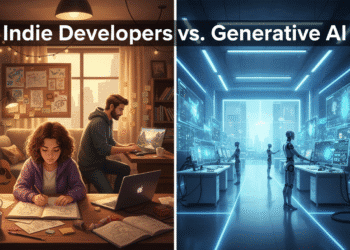In a move that underscores the federal government’s increasing comfort—and perhaps cautious enthusiasm—with artificial intelligence, approximately 1,500 U.S. federal workers are now equipped with a groundbreaking AI chatbot named “GSAI.” This initiative, spearheaded by the General Services Administration (GSA), aims to boost productivity, streamline communication, and cut through the bureaucratic tangle of daily tasks. But as AI makes its way into the very heart of governmental operations, questions remain: is this the dawn of a more efficient bureaucracy, or could we be witnessing the early chapters of a cautionary tale?
A Bold Move into AI Territory

Announced recently and detailed extensively by Wired, the GSAI chatbot pilot program marks a notable stride toward integrating advanced AI technologies into federal workflows. Wired reports that this chatbot is designed not just to handle rudimentary queries but to manage more nuanced requests typical of government employees. Need help navigating cumbersome federal policy? GSAI is there. Stuck trying to draft standardized emails? GSAI offers suggestions instantly. In short, the federal government is betting big on AI’s promise to boost efficiency and improve day-to-day workflow.
Yet, the rollout isn’t just about making life easier. It’s part of a larger strategy to position the federal workforce as early adopters in the AI landscape—a move that, proponents argue, could lead to a transformative shift in government efficiency and responsiveness.
How It Works: Efficiency in Action
At its core, GSAI operates like many popular generative AI systems familiar to the public. It ingests vast amounts of government-specific data and uses complex machine learning algorithms to generate accurate, context-aware responses. Federal employees participating in the pilot can access GSAI through secure government platforms, engaging the chatbot to streamline a variety of tasks—from drafting reports to summarizing lengthy policy documents.
The anticipated outcome? Significant productivity gains. Early internal assessments hint at substantial reductions in the time federal workers spend on repetitive tasks, freeing them up for more strategic, complex projects. The impact could ripple outward, significantly reshaping how the government manages resources, communicates internally, and even interacts with the public.
But like any transformative technology, GSAI isn’t without its skeptics.
The Big AI Question: Trust and Transparency
The integration of AI into government operations naturally raises eyebrows. One immediate concern is the potential for AI-generated misinformation, or worse, misuse of sensitive data. How transparent is the decision-making process of an AI like GSAI? Who is accountable when mistakes occur?
In response, the GSA has emphasized transparency and stringent safeguards. Wired highlights that the chatbot comes equipped with clear parameters for usage, robust privacy protections, and rigorous oversight mechanisms. Yet, assurances haven’t silenced critics, particularly given AI’s historical struggles with bias, security vulnerabilities, and ethical quandaries.
The GSA is fully aware of these concerns. It has made clear that GSAI is still firmly in the pilot stage—actively monitored, with human oversight constantly in the loop. The chatbot will undergo continuous scrutiny and refinement as part of an ongoing effort to mitigate potential risks and reinforce public trust.
AI and the Changing Face of Government Employment
Perhaps most intriguing about the GSAI rollout is what it signals about the future of federal employment. Historically viewed as resistant to rapid technological shifts, the federal workforce now finds itself at the cutting edge of a transformative tech trend. Could widespread AI adoption fundamentally alter federal jobs?
Some employees express unease. Job security in an AI-driven landscape is a legitimate concern, as automation has historically displaced roles. However, supporters suggest AI’s role will primarily be supportive rather than substitutive, enhancing human workers’ efficiency and enabling more meaningful contributions.
Indeed, early feedback from the pilot suggests employees appreciate the reduction of tedious tasks, reporting greater job satisfaction. If successful, the GSAI pilot could lead to broader AI integration across multiple agencies.
Lessons from the Private Sector
The federal government isn’t venturing into AI without precedents. Private-sector experiences with AI deployment offer valuable lessons—and warnings. Companies that have successfully embraced AI typically emphasize transparent implementation, rigorous oversight, and ongoing employee training. Conversely, organizations that have fumbled their AI integrations typically failed to address issues of transparency, privacy, and accountability from the start.
The GSA’s cautious yet optimistic approach appears to mirror best practices seen in the private sector. By learning from both successes and failures, the agency hopes to avoid common pitfalls that have plagued earlier AI implementations.
Next Steps: Monitoring and Expansion
As GSAI continues its pilot phase, rigorous monitoring and assessment remain critical. Success metrics, according to the GSA, include not just productivity gains but also employee satisfaction, accuracy of outputs, and compliance with privacy standards. Positive outcomes could pave the way for expanded deployment, potentially influencing AI strategy government-wide.
Conversely, negative outcomes or significant setbacks might cause the government to reconsider the pace and scale of AI adoption, reflecting a more cautious approach.
Conclusion: Innovation or Overreach?

The federal government’s embrace of GSAI represents a decisive moment. If successful, the pilot could mark a turning point toward a smarter, more agile bureaucracy. Yet the initiative is fraught with risks—privacy concerns, job security fears, and potential misuse—each demanding careful consideration.
Will GSAI fulfill its promise, enhancing efficiency and transforming federal work, or will it become another cautionary tale of technological overreach?
One thing remains clear: as 1,500 federal workers engage daily with an AI assistant, the rest of the nation watches closely. The results could shape not only federal policy but also broader societal attitudes toward the integration of artificial intelligence.









